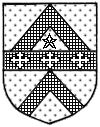|
|
 |
Instructions for Blazoning*
a Coat-of-Arms
|
*(i.e.,
describing in
heraldic terms) |
1 |
Begin by giving the color of the field (i.e., background)
of the shield. When a coat-of-arms or armorial is represented
in black and white, the tinctures (i.e., colors) are
indicated by various patterns (see Metals,
Tinctures, and Furs).
If the
field is divided into more than one color, describe first
the partition of the field (i.e, how the field is divided
— see Methods
of Partition)
and second the color of each section. Begin with the most
important section of the shield, which is always the top and/or
viewer's left section:
- If
the shield is parted per fess (i.e., divided in half
horizontally), the upper half or upper armorial is the more
important of the two.
- If
the shield is parted per pale (i.e., divided in two
vertically), the left half or left armorial is the more
important of the two.
- If
the shield is quartered (i.e., divided both horizontally
and vertically), the upper left quadrant is the most important
one. (For more information on each of these three types
of divisions, see Marshalling
of Arms.)
If the
field is semé (i.e., strewn with) anything,
this should be indicated now (see Semé
Patterns).
|
|
Example
from
the Bookplate
Collection
Or
on a fess between
two chevrons sable
three crosses-crosslet
argent, a molet
for difference.

|
2 |
After the field's color has been blazoned, the next aspect to
address is how any charges (i.e. the objects or ordinaries
on the field — see Heraldic
Charges) found on the field. If there is more than one object
at the center of the shield, state the number and position of
the objects (see Positioning
of Charges). |
|
Or on a fess between
two chevrons sable
three crosses-crosslet
argent, a molet
for difference.
|
3 |
List any secondary charges which surround the main object,
including their color and position on the shield.
- Note
that if the main object and the secondary objects are of
the same color, the color is stated only after the secondary
objects.
|
|
Or on a fess between
two chevrons sable
three crosses-crosslet
argent, a molet
for difference. |
4 |
List any objects which rest on the objects described in steps
2 and 3. |
 |
Or on a fess between
two chevrons sable
three crosses-crosslet
argent, a molet
for difference. |
5 |
If there is a chief, a bordure, a quarter,
a canton, or an escutcheon of pretense (see
Ordinaries
(Page 1) for chief or bordure, Ordinaries
(Page 3) for quater, canton or escutcheon), indicate that
now along with the item's color and any divisions which occur
within it.
- Any
of these items can be divided and bear charges in the same
manner as the main portion of the shield, and should be
described as outlined in steps 1 through 4.
|
|
|
6 |
List any marks of cadency which are present (see Cadency
Marks). |
|
Or on a fess between
two chevrons sable
three crosses-crosslet
argent, a molet
for difference. |
|



